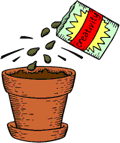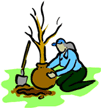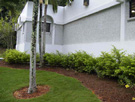|
|
 |
|
|
|
SPRING PLANTING TIME!
Gardening tips for warm climates Early: If you've planted tender plants, protect them if you have late frost. Add fertilizer, lime and organic material to other beds to prepare them for more plantings. Mid: Finish planting summer annuals and vegetables. Water new plantings if rain is not sufficient. Ample moisture now helps establish a good root system. Late: Mulch planting beds to help retain moisture and keep weeds down. Fertilize as necessary. Starting from seed
Some seedlings don't like to be moved and should be sown directly into the soil. Others can be started indoors. Do research or just check the back of the seed package before you begin. Choosing plants at the nursery
Spring isn't the best time to do all your planting, but it seems to be the time when we're most motivated. Now, get out there and cultivate!
TOP
TEN REASONS WHY LANDSCAPERS 10. I read about it in a magazine. 9. I saw another landscape company doing the same thing and thought it looked good. 8. My company spent $149 on the Ortho Problem Solver book. 7. An old man down at the coffee shop recommended it. 6. One of our laborers did it by accident and the Supervisor liked it and took credit for it. 5. I heard a college professor talk about it at an all-day seminar. 4. My wife read about it in Southern Living magazine. 3. I was out sick one day and watched the Garden Channel for 8 straight hours. 2. My company spent $25,000 on a new computer program that recommended it. And the #1 reason why Landscapers do it that way: 1. OLM told me to do it that way!
|
|
 When
winter succumbs to warm weather, gardeners everywhere are itching
to dig in the dirt. You can begin early and enjoy gardening throughout
the growing season, wherever you live.
When
winter succumbs to warm weather, gardeners everywhere are itching
to dig in the dirt. You can begin early and enjoy gardening throughout
the growing season, wherever you live. The
key to planting at the best time is generally based on the last
expected frost date. Early spring refers to the 3 to 4 weeks
before the last frost. Mid-spring refers to the 3 to 4 weeks
after the last expected frost and late spring refers to several
weeks after the last frost.
The
key to planting at the best time is generally based on the last
expected frost date. Early spring refers to the 3 to 4 weeks
before the last frost. Mid-spring refers to the 3 to 4 weeks
after the last expected frost and late spring refers to several
weeks after the last frost. By
far the least expensive way to garden is to start plants from seeds.
A package of seed generally costs less than two dollars and you
can get many plants from one package. In addition, the variety of
plants available is much greater than purchasing plants from a nursery.
By
far the least expensive way to garden is to start plants from seeds.
A package of seed generally costs less than two dollars and you
can get many plants from one package. In addition, the variety of
plants available is much greater than purchasing plants from a nursery. 1.
If a local nursery is selling a type of plant, it will thrive
in the region. Not always true. Any plant will survive
anywhere with the right amount of attention. It is always
best to use plants that are proven to do well in your area
- let somebody else experiment.
1.
If a local nursery is selling a type of plant, it will thrive
in the region. Not always true. Any plant will survive
anywhere with the right amount of attention. It is always
best to use plants that are proven to do well in your area
- let somebody else experiment.
 7.
Chemicals are safe in the garden. Chemicals such as
fertilizers and pesticides are only safe when used properly.
The mildest chemical can become hazardous if used in an unsafe
manner. Always read the label and follow instructions.
7.
Chemicals are safe in the garden. Chemicals such as
fertilizers and pesticides are only safe when used properly.
The mildest chemical can become hazardous if used in an unsafe
manner. Always read the label and follow instructions.